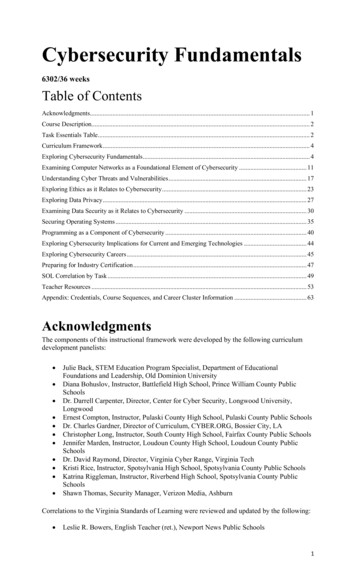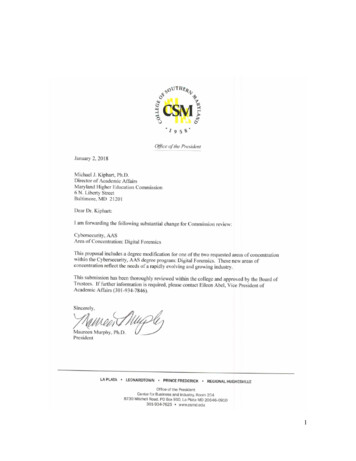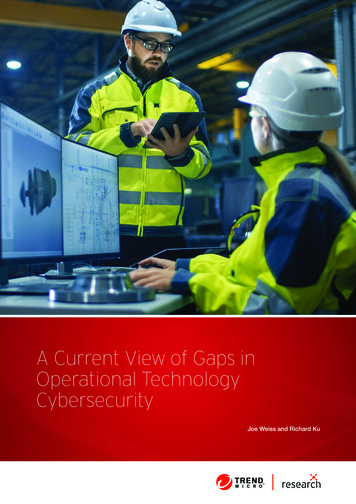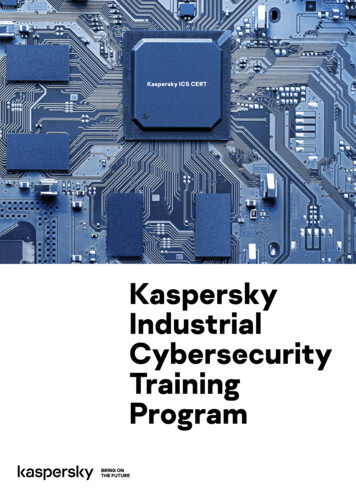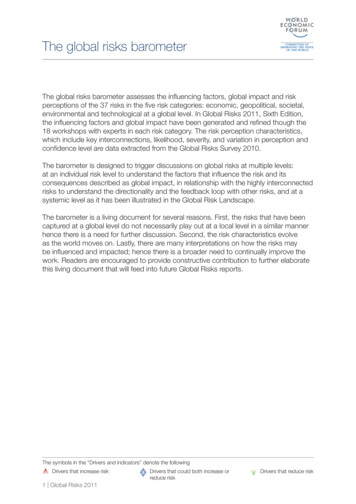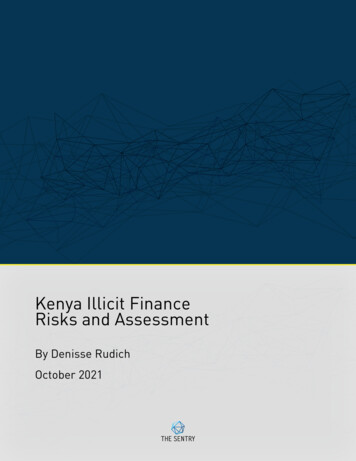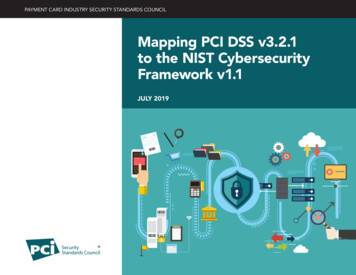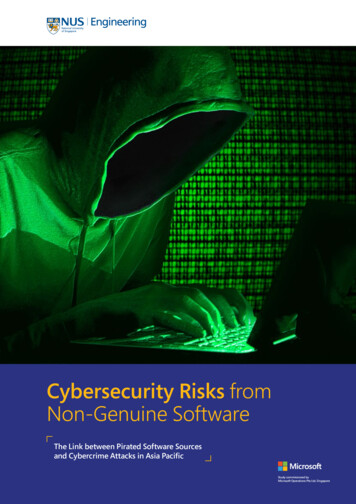
Transcription
Cybersecurity Risks fromNon-Genuine SoftwareThe Link between Pirated Software Sourcesand Cybercrime Attacks in Asia PacificStudy commissioned byMicrosoft Operations Pte Ltd, Singapore
Cybersecurity Risks from Non-Genuine SoftwareFOREWORDSecurity is an ever-growing concern and the number ofsecurity breaches and their impact has increased withtime, despite efforts to improve cyber defenses.One of our key motivators behind this research was toinvestigate how malware infects computers, particularlyin the context of Asia Pacific. Pirated software is stillprevalent in the region and we wanted to characterizethe link between software piracy and cyber risks. A totalof eight countries were involved in this study – Malaysia,Indonesia, Thailand, Vietnam, Sri Lanka, Bangladesh,South Korea, and Philippines.The means through which people acquire piratedsoftware has changed over time, with downloads frompeer-to-peer networks such as BitTorrent becomingincreasingly popular. We found that the downloadingand installation of pirated software is fraught with malware exposure at every step. It is evident thatcybercriminals are increasingly using this medium to infect computers, steal information, createbotnets etc.That said, traditional methods of acquiring pirated software, such as buying counterfeit CDs and DVDsas well as preloading them in new computers by unscrupulous sellers, remain prevalent in this region.And we found that these non-genuine software frequently come with malware bundled with them.This shows that malware spreading through pirated software is still one of the common means ofinfection and more awareness among the users is needed.This report also highlights multiple risks associated with pirated software that users are usuallyunaware of, or may not fully appreciate the severe consequences. In addition to the significantpossibility of installing malware, getting a pirated software to work usually requires disabling manyof the security-related features that puts the computer at serious risks. In many cases, a false sense ofsecurity may also come from the use of pirated anti-virus software, which, in reality, do not offer muchof a protection and may include malware of their own.Lastly, we wanted to use this opportunity to share best practices that organizations and individuals canadhere to better protect themselves and their data. At the end of the day, the most effective way forusers to stay safe is to use genuine operating system and anti-virus software, which are updated andpatched regularly.Associate Professor Biplab SikdarDepartment of Electrical & Computer EngineeringNational University of Singapore (NUS) Faculty of Engineering2
Cybersecurity Risks from Non-Genuine SoftwareINTRODUCING THE NUS RESEARCH TEAMAssociate ProfessorBiplab SikdarRahul Singh ChauhanDepartment of Electrical &Computer EngineeringQualification:B.Tech in Mechanical Engineeringfrom National Institute ofTechnology, Kurukshetra.National University of Singapore,Faculty of EngineeringPursuing:M.Tech in Software Engineeringfrom NUS.Siddharth DeshmukhRamkumar RajendranRitesh KhuranaQualification:B.Tech in Electronics andCommunication Engineering fromUttar Pradesh Technical University,India.Qualification:B.Tech in Electrical and ElectronicsEngineering from Amrita VishwaVidyapeetham University, India.Qualification:B.Tech in Electronics andCommunication Engineering,from the National Institute ofTechnology, Kurukshetra, India.Pursuing:M.Tech in Software Engineeringfrom NUS.Pursuing:M.Sc in Electrical Engineering(Computer EngineeringSpecialization) from NUS.Pursuing:M.Sc in Electrical Engineering fromNUS.3
----------- --- 9The Findings---------------------------------------- ------- --- 22Annexure---------------------------------------- 24
Cybersecurity Risks from Non-Genuine Software1. INTRODUCTIONa.Rise of Digital Transformation: Digital information and computing technologies have permeated our daily lives.Starting from the prevalence of social media and networking affecting personal lives, computer based technologieshave had a significant impact in the way we shop, access government services, connect with people, and interact withentertainment content.Digital technologies are also starting to transform our economies and industries. The advent of machine learningand artificial intelligence (A.I) to interpret and make decisions based on advancements in the areas of big-dataanalytics and cloud computing, coupled with the rise of the Internet of Things (IoT) to facilitate the collection anddissemination of data, are some of the key driving forces of this transformation.The digital transformation of our personal, social, and work environments has led to an increasing dependenceon communication and computing technologies. We rely on the ready access to data and cloud-based servicesfor many of our personal and business needs. These technologies provide convenience and efficiency and are awelcome opportunity.Digital transformation is changing the way we work, play and interact with each other.5
Cybersecurity Risks from Non-Genuine SoftwareHowever, they also come with a wide range of cybersecurity issues. The improper use or use of untrusted informationtechnologies can lead to serious cybersecurity risks and challenges for both organizations and governments but alsosmall businesses and individuals.Inadequate cyber-defenses such as improperly configured (or absent) firewalls and anti-virus software, use ofunpatched software, lack of awareness on strong passwords and phishing attacks, lack of appropriate informationtechnology policies and their implementation (e.g. on encryption, multi-factor authentication) etc. are some of therisk factors.Additionally, in many parts of the world, the use of pirated/counterfeit/non-genuine software is a serious contributorto the growth of cyber-risks and is responsible for extensive economic harm and productivity losses. It is also causinga rise in cybercrime attacks and related losses.According to BSA, in 20163 in 5 PCs 19 billionin Asia Pacific wereusing pirated software.– value of Asia Pacific’spirated software market.Software piracy is an acknowledgedglobalproblemwhoseimpacton industries, governments, small businessesand individual users goes far beyondeconomic issues. According to recent studies,the global piracy rate for personal computer(PC) software was around 39% in 2016, andthe commercial value of the market forpirated software was 52.2 billion [1].While pirated software is fairly prevalentamong individual users, the rate of unlicensed use in banking, insurance, and securities industries is 25%, despitethe latter having a stricter enforcement of regulations. While the economic implications of software piracy in termsof harm to intellectual property, revenue losses, lost jobs and taxes receive significant attention in the media andacademia, another significant impact of pirated software comes in the form of an assortment of cybercrime risks.Pirated software are increasingly becoming associated with the spread of various forms of malware (malicioussoftware) such as worms, viruses, trojans, spyware, adware, droppers, to name a few. It is known that the malware areconfigured by cyber criminals to take advantage of various vulnerabilities in the host computer or a set of systems,to use or compromise sensitive/private information, steal money or disrupt, and can be executed and controlledremotely and covertly.b.Malware Infections through Pirated Software: Malware in pirated software may originate from various sources.In certain cases the malware comes pre-installed or embedded in with the pirated operating system or applicationsoftware at the point of sale.Alternatively, some of the pirated software may require the user to visit certain websites to download activation keysor software bits, where such malicious websites install/drop malware onto the computer.A third mechanism for the transfer of malware through pirated software comes from writable CDs (compact disks)and DVDs copied with pirated software. They may be purchased from online market places or brick-and-mortarstores. In many cases, these unauthorized CDs and DVDs come bundled with additional unwanted software andmalware, which also gets installed along with the main application.Finally, computers may also get infected with malware when visiting websites or peer-to-peer (P2P) services that offerpirated software downloads. Many of the pirated software also tamper with the systems, user accounts and securitysettings that are recommended by the vendors of the original software. We will discuss some of those examples inthis study. Overall, such computers with pirated software become highly prone to easy malware infections.6
Cybersecurity Risks from Non-Genuine SoftwarePirated CD and DVD samples that the NUS researchers acquired for this study.c.Impact of Malware Infections: The primary impact/risks associated with malware are time, money and lossof confidential/private data of the users. A common impact of using pirated software is the loss of time andproductivity due to the behavior and actions of the malware. Examples of malware-inflicted loss of time includeslowing of computers, inundation with pop-up advertisements, corrupted files, increased need for cleanups andreinstallations etc.Many of the malware forms are targeted at stealing financial information and specialize in stealing credit card,identity and banking information. Such malware facilitate illegal financial transactions and their impact can bedirectly evaluated in economic terms. Malware such as key-loggers may also steal username and passwords foremail, online accounts, and social networking websites and then use those accounts to send information promotingscams, websites selling dubious products, digital piracy, pornography, etc.While the impact of such malware is difficult to quantify in exact economic terms, it is well-established that riseof cybercrime attacks can cause enormous personal, reputation, economic and business losses, including risks tonational security of the governments.7
Cybersecurity Risks from Non-Genuine Softwared.Objectives of this Study: The objective of this report is to present the results and the analysis of our research studyto quantify the relationship between software piracy and malware infections.One of the primary goals of our study was to check what malware infections come with new personal computers (PCs)which are installed with pirated software at the point of sale/shops, directly in the hands of the users – a commonpractice around the world, particularly in the developing countries.The study aims to demonstrate and highlight the fact that such new PCs are increasingly coming pre-infected withmalware before they have been used by the users and even before the PCs connect to the Internet or externalstorage devices. These trends reflects how malware is maliciously embedded in the uncontrolled and unauthorizedsources of pirated software, that isoften controlled by cybercriminals and organized criminal syndicates.The second objective of the study was to investigate pirated software, that can be bought from brick-andmortarshops or downloaded from the Internet, for presence of malware.The overall objectives of the study are(i)Provide evidence of the presence of malware in computer hardware procured through publicdistribution chains, pirated software CDs and DVDs, and pirated software downloaded fromthe Internet.(ii)Highlight the cybersecurity risks and cybercrime threats posed by such malware and the effects they may haveon consumers, small businesses & organizations.The study is based on an in-depth analysis of 458 samples from 8 countries in Asia-Pacific. These samples consistsof, a combination of PCs installed with pirated software, software CDs/DVDs copied with pirated software,and online downloaded copies of pirated software. Each of these software samples and PC “samples” werethoroughly investigated for the presence of malware infections and signs of tampering with the software, user andsecurity settings.Based on this analysis, the major findings of our study are:(i)55% of the total samples were infected with malware, of which over 90% infectionswere in the PC samples.(ii)Main strains of malware found were trojans, viruses, adware, etc.(iii) In addition to the malware in the PCs & CDs/DVDs, significant threats existed in theform of malware that is encountered in the websites that offer links to pirated software.8
Cybersecurity Risks from Non-Genuine Software2. METHODOLOGYThis section described the methodology followed during this study. The overall methodology consists of three steps.The first step is the procurement of personal computers, physical media such as CDs and DVDs, and the onlinesoftware downloads that serve as the samples for our study. The subsequent steps are related to the investigation ofthe samples for the presence of pirated software and malware. The details of the individual steps of the methodologyare presented below.a.Sample procurement: The sample procurement step involves the purchase of computers and software for analysisfrom across the markets in Asia-Pacific (Malaysia, Indonesia, Thailand, Vietnam, Sri Lanka, Bangladesh, South Korea,and Philippines). Towards this end, a total of 90 samples of personal computers and laptops from these 8 countriesfrom south east Asia were procured.Additionally, 165 CDs and DVDs containing software were also acquired. These samples were purchased from thetarget countries on a random basis, from PC and software vendors. These vendors could be standalone shops instreet markets, or located in IT market hubs (for example, an open market full of shops located in the same zonedoing similar business), or PC shops in specialized IT malls. The shops visited for this study included multi-brand,single brand, PC assemblers and IT retail chain stores.Our team conducted a similar study in 2014 [2].The previous study mainly focused on laptopsand desktop PCs with pirated software. Inthe current reboot of the study, our choice ofsamples reflects the growing trend wheresoftware is increasingly being acquired throughonline downloads. In addition to laptops anddesktops with pirated software, this study alsoconsiders CDs and DVDs, as well as piratedsoftware available online, for example frompeer-to-peer networks.The purchases were done by independent investigators who would act on a pretext of a “normal walk-in customer”such as student, young professional, home maker, small business owner, etc. The objective was to target everyday PCdistribution and sales business model which interacts with walk-in customers, and where piracy, by way of hard-diskloading, happens the most. This option is usually offered as an incentive to drive the PC sales.It is important to note that the test purchasers did not specifically ask for computers with pirated software. The testpurchasers usually discuss the PC brand options, features, configurations, pricing, deals/discounts etc. Our empiricalobservation suggests that through this discussion and negotiations, free installation of software is generally offeredand agreed by the shop sales person as an added incentive to make the sale.9
Cybersecurity Risks from Non-Genuine SoftwareIn addition to the “physical” samples consisting of hard drives from computers and CDs/DVDs, 203 software sampleswere downloaded from the Internet. These samples were available online as torrents and were downloaded usingthe BitTorrent peer-to-peer software.Online search engines (e.g. torrentz2.eu) that specialze in torrent files were used to serch for downloadable software.While a wide range of software is available for downloads, our samples were restricted to well known software titles,including operating systems, design, productivity tools, anti-virus engines etc.b.Sample imaging: The first technical step in our methology consisted of creating a software image of the harddisk from each of the samples. The image is usually created by making a sector-by-sector copy of the contents ofthe hard disk. The primary reason for creating an image is to allow easy analysis of the sample without the risk ofcontamination or modification of the original sample.To achieve this objective, the actual malware analysis on the sample is done on a copy of this image. Consequently,the impact of any inadvertant action by the anti-virus engines or any breakout is limited to the copy of the image.Images were also created for the software downloaded from the Internet as well as those from CDs and DVDs. In thecase of CDs and DVDs, the primary motivation for creating the images was to speed up the malware detection (sincethe speeds of the CD/DVD drives limits the scanning rates).The images were created using software tools that create VHD(Virtual Hard Disk) versions of physical disks and these imagesconform to Microsoft’s Virtual Machine disk format. These VHDbased disk images can be directly used in various virtual machine(VM) environments that are needed for the system investigationand behavior analysis steps of the methodology. For the purposesof this study, virtual machines were used. All partitions of the harddisks were selected when creating the images.Avoiding SampleContamination:In a large-scale malware study,samplecontaminationisalways a concern. Care shouldbe taken so that malware froma sample does not spread toothers. Also, the integrity ofthe sample between scans bydifferent anti-virus engines isnecessary. In our study, theseobjectives were achieved bycreating their software imagesand conducting all malwareanalysis on these samples.Hard disks from brand new PCs that are preloaded with pirated software.10
Cybersecurity Risks from Non-Genuine Softwarec.Malware detection: The malware detection step consists of scanning each of the sample images with anti-virussoftware. For this study, the following seven anti-virus engines were used: AVG, BitDefender, Ikarus, Kaspersky,McAfee, Norton, and Windows Defender. For scans on a given sample, for each anti-virus engine, a separate copy ofthe software image of the sample was used. This was done to ensure that each anti-virus engine scans the same (andoriginal) image of the sample and any inadvertent modification of the sample that may be made by an anti-virusengine during a scan does not impact the results of subsequent scans.For each scan, the following basic rules were applied:1.Before each scan, the latest definitions and updates for the anti-virus engine were downloaded.2.The settings for the anti-virus engine were set to scan all files and directories.3.The options for automatically removing malware was turned off. At the end of each scan, the malware samplesare copied and saved for further investigation.4.The output of the scan including the details of the malware identified, their locations etc. is recorded.At the end of the scans from the seven anti-virus engines for each sample, the results were collated and the numberof unique malware in each sample was counted.Variation in Capabilities of Anti-virus Software:Most organizations and individuals rely on a single anti-virussoftware to protect their assets. Our study shows that this islargely ineffective and there are many malware samples thatare detected by one anti-virus software but missed by others.Thus, we used 7 different anti-malware software to thoroughlyexamine the samples.11
Cybersecurity Risks from Non-Genuine Software3. THE FINDINGS:This section presents the details of the results of the study, as follows:a.PCs, and CDs/DVDs with pirated software: Our study found anoverwhelming majority of the new computers with pirated software (92%),that were analyzed, were infected with malware. This result is particularlyimportant considering that the samples were brand new computers thatwere previously unused.The presence of malware in these computers should be of particular concernto consumers, who naturally expect new computers to be risk-free.Additionally, our study found that of the 165 CD and DVD samples that wereinvestigated, 100 samples contained malware, resulting in an infection rateof 61%.92%Brand new,unused softwarewere infectedwith malwareThe bulk of the malware found in these samples were trojans, droppers,and adware. These malware (more details are provided subsequently inthis section) expose the users to a wide range of security and performanceissues. Some of the malware such as adware may cause disruptions and performance issues due to pop-upadvertisements and unwanted processes running on the computer. Of greater concern are Trojans, key-loggers, andbackdoors that can download additional malicious software on the infected computer, delete and encrypt files, andallow hackers to gain remote access of the computer.61%Pirated DVDs & CDs wereinfected with malware5Average no. of malware strainson an infected CD or DVD38No. of malware strainsfound on some DVDsMalware patterns in CD/DVDs: The bulk of the malware present in the CD and DVDsamples were Trojans and Droppers. Once the software in these CDs and DVDs areinstalled, the infected computers will likely see a rise in infections and anomalousbehavior as additional malware is automatically downloaded. Infected CDs typicallyhad multiple strains of malware, and on an average, each infected CD/DVD has 4.9instances of malware. We also observed large instances of malware in some cases,with 38 pieces of malware in just one DVD.12
Cybersecurity Risks from Non-Genuine Softwareb.Downloaded pirated software: Among the 203 samples of software downloaded from the Internet, our study notonly found malware presence in several samples, we also encountered various security risks and malicious threatsto the users who were made to visit such websites. We were able to establish that the web links to thesepirated software were posing several risks since they made attempts to infect the computer through maliciousadvertisements and software downloads which were able to bypass anti-virus software checks.It was reported that in 2015, almost a third of torrent websites served malware to their visitors andaround 12 million users were infected (per month) by visiting these websites[3]. Our own investigationssupport these reports and found that visiting websites with links to torrent files lead to malwaredrops, pop-up ads, and misleading links aimed at tricking visitors. Additional details of malwarerisks associated with downloading pirated software are highlighted in our analysis later inthis report.A NUS researcher accessing a torrent website and analyzing the cyber risks encountered.The common pirated software downloaded include the Microsoft family of operating systems, Microsoft Officesuite of software, document and image handling software by Adobe, file compression software such as WinRAR,and other popular software such as CorelDRAW and AutoCAD. Perhaps more interestingly, we observed anumber of cases where malware was bundled with anti-virus software that was being distributed in the DVDs andCDs. Using such compromised security software not only infects the computer to begin with, it also does lulls theusers into a sense of complacency and keeps the computer open for further exploitation.13
Cybersecurity Risks from Non-Genuine SoftwareSeveral categories of software were downloaded for analysis.Here are the infection rates for different categories of pirated software.Productivitysoftware:42%a.Operating systems andsystem software:29%Games and apps:19%Anti-virus software:17%Types of Malware: The results presented above give a quantitative view of the results of the study. Further analysisinto the nature of the malware infecting the samples highlights the common modes used by cyber criminals tosteal the personal and financial information of the computer’s owners.Additionally, our results show some of the common methods used by these cyber criminals to get users, throughpirated software, to compromise their computers. Our observations are described below.i.Trojans: The most common family of malware encountered in our study was Trojans. Trojans are a class ofmalware that typically distinguish themselves as legitimate software are often employed by cyber criminals togain access to computers.While Trojans typically depend on some form of social engineering to trick users into loading and executingthem [4], bundling them with pirated software makes it easier for cyber criminals to compromise andcontrol computers.Once a Trojan is active in an infected computer, they can allow the cyber-criminals to spy on the users andsteal the private data. Additionally, Trojan can open backdoors to allow remote access and control of thecomputer, modify and delete data, and degrade the performance of the computer.Some of the common Trojan strains that were seen in the samples include Downloader, Floxlib, Wpakill,Pioneer, Turkojan, FakeGina, and WrongInf.Trojan Win32:Skeeyah.A!rfnThis Trojan was frequently found in our samples and itsmain purpose is to create a backdoor for the attacker togain remote access on the compromised computer.The malware modifies the registry and firewall settings,and may disable anti-virus programs. and is designed tosteal sensitive data from the infected computer. Oncethe malware installs a backdoor, the attacker can gainaccess to private information stored on the computer,send spam, and launch ‘denial of service’ attacks.14
Cybersecurity Risks from Non-Genuine Softwareii.Viruses and worms: The study also found a large range of worms, viruses and other forms of infectioussoftware in the samples. Unlike Trojans that are not able to self-replicate, computer worms can replicatewithout human intervention and have the capability to spread more rapidly.Worms and viruses may execute malicious code that deletes files with certain extensions and/or beginningwith specific strings, terminate security-related programs and services such as firewalls and anti-virussoftware, send spam messages, and contact remote hosts to download additional malware.Common worms and viruses encountered in our study included Virut, Nuqel, Jenxcus, Sality, and Xorer.worm VBS/Jenxcusworm VBS/JenxcusThis malware allows cyber criminals to gain remote access tothe infected computer. Once installed, the worm can create abackdoor for the hacker to command the infected computer.Additionally, the malware can record the usernames andpasswords that the computer’s owner uses on variouswebsites and send all this information to cyber criminals.The malware can also delete or update files on the infectedcomputer, execute any commands that the cyber criminalswant, open websites, and download files to the computer.iii.Other malware: In addition to worms and viruses, the samples also contained malware that may be classifiedas adware, hacktools, and droppers.Adware are software that automatically download and display advertising material on the infected computer.Adware may also redirect search requests made on the infected computer to advertising websites andcollect private user information (e.g. the types of websites visited) in order to enable customizedadvertisements to be downloaded.Hacktools are programs used by cyber criminals to gain access to the infected computer and are used fora number of malicious activities. Such activities include logging the keystrokes on the computer, stealingand cracking passwords, sending spam emails, and acting as port and vulnerability scanners.Some of the adware found in our samples include yabector, Adon, OpenCandy, SwBundler, and Amonetize.adware AmonetizeAmonetize is an adware that often comes bundled with softwareinstallers (e.g. in .RAR and .ZIP files) and is dropped on the computerduring the installation process. This adware has the ability to abilityto change computer settings, installing toolbars in browsers, displayadvertising banners, pop-up advertisements, in-text advertisements,and browser popups that recommend fake software updates.While Amonetize may sometimes have legitimate uses, it is mainlyused for malicious purposes including generating advertisingrevenue, browser hijacking, and manipulating page ranks insearch engines.15
Cybersecurity Risks from Non-Genuine SoftwareHigh-risk malware examples found in online samples1)Trojan/Omaneat:Collects username and passwords, targets banking details and social media.2) Trojan/ChePro:This Trojan is designed to steal user account data relating to online bankingsystems, e-payment systems and plastic card systems.3) Trojan/Skeeyah:It installs a keylogger on the infected computer to record informationabout browsing history, online searches, banking operations and variousonline accounts such as social media or emails and their passwords.4) Malware/Artemis:Artemis is a malware that affects the work of web browsers by changing thehomepage, redirecting search engine queries to advertisement pages, andcreating pop-up windows.b.Infection Patterns: As defensemechanisms against cyberthreats evolve, developers ofmalware have also adapted tothese changes to continue withtheir quest for compromisingandexploitingvulnerablecomputers for financial gains.NUS researchers scanning pirated software samples for malware infections.16
Cybersecurity Risks from Non-Genuine SoftwareWhile traditional methods of procuring pirated software through brick-and-mortar shops or roadside kiosks is stillpopular in many parts of the world and South-east Asia, increasingly, such software is being downloaded throughwebsites and peer-to-peer networks. Consequently, malware developers have targeted the distribution of malwarethrough the forums used for the online distribution of pirated software.Also, our study shows that malware develop
Cybersecurity Risks from on-Genuine Software 7 c. Impact of Malware Infections: The primary impact/risks associated with malware are time, money and loss of confidential/private data of the users. A common
